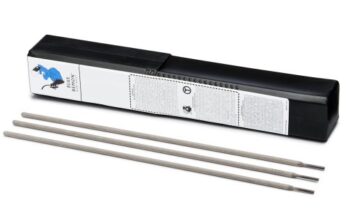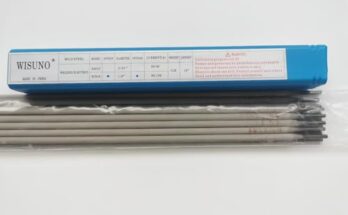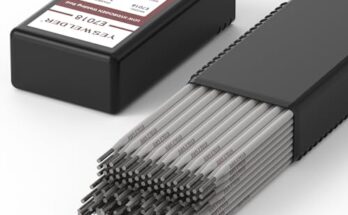Need to tackle a welding project? Let’s dive into the world of hobart welding rods. This guide will cover everything you need to know, from choosing the right rod to mastering welding techniques.
Hobart is a well-respected brand in the welding industry, known for producing high-quality equipment and consumables. Hobart
welding rods, also known as electrodes, are metal sticks coated with a flux material. This flux plays a crucial role in the welding process. When you strike an arc, the heat melts both the rod and the base metal, creating a weld pool. The flux protects the molten metal from atmospheric contamination (like oxygen and nitrogen), ensuring a strong and clean weld. This isn’t just about theory; I’ve seen firsthand how a poor-quality rod can ruin an otherwise perfect weld. The quality of the Hobart rod makes all the difference. Think of it like this: using a high-quality Hobart rod is like using a premium paintbrush compared to a cheap one—the result is noticeably superior. The difference in weld quality becomes very apparent when working on larger projects or when precision is key.
Types of Hobart Welding Rods and Their Applications
Hobart offers a wide range of welding rods designed for different applications and materials. They are categorized by their electrode classification (like E6013, E7018), which indicates their properties, such as tensile strength and weldability. For example, E6013 rods are popular for general-purpose welding, ideal for beginners. They offer good arc stability and are relatively easy to use, making them perfect for home projects or less demanding applications. They’re great for thin sheet metal and offer decent penetration. On the other hand, E7018 rods are designed for low-hydrogen welding, crucial for applications requiring high strength and excellent corrosion resistance, often used in pipelines or structural steel applications. Their lower hydrogen content produces a stronger, more durable weld. I’ve personally used both extensively and found the E6013 perfect for everyday repairs, while the E7018 was essential for a recent project involving heavy-duty steel fabrication. The right rod for the job drastically improves both the welding process and final product.
Key Features and Benefits of Hobart Welding Rods
Hobart welding rods are prized for their consistent quality, reliable performance, and superior weld quality. Their consistent chemical composition guarantees predictable results, which is essential for achieving strong, reliable welds every time. This consistent quality has saved me countless hours and headaches on the job site. No more struggling with inconsistent welds or having to redo work due to poor-quality rods! Many competitors often have inconsistent rod diameters, leading to irregular welds, but Hobart keeps a consistently accurate diameter, optimizing heat distribution and leading to a smoother welding process. This consistency in quality is really a key selling point, making them a favorite among experienced welders and beginners alike. Moreover, their robust coatings provide excellent arc stability, making them easier to control and reducing spatter, which leads to a cleaner, more aesthetically pleasing weld.
Choosing the Right Hobart Welding Rod
Matching the Rod to the Metal
Choosing the correct Hobart welding rod is paramount. It’s not a one-size-fits-all situation. The type of metal you’re welding will dictate the appropriate rod type. Steel, stainless steel, and aluminum each require specific welding rods with unique compositions to ensure proper fusion and desired weld properties. For instance, welding mild steel requires a different rod composition than welding stainless steel. Using the wrong rod could result in a weak, brittle weld that is prone to cracking or corrosion. It’s crucial to understand the metal’s properties and select a rod designed for that specific material. For example, stainless steel requires a rod that can withstand high temperatures and resist corrosion. Failing to do so can lead to a subpar weld. Always check the manufacturer’s specifications and recommendations to select the appropriate rod for your application.
Understanding Welding Rod Specifications
Welding rods are marked with codes that indicate their properties. Understanding these codes is vital for selecting the right rod. These codes typically follow a standardized system, such as the AWS (American Welding Society) classification. For example, an E6010 rod indicates a tensile strength of 60,000 psi (pounds per square inch), a cellulose-based coating, and good penetration. The number following the E indicates the tensile strength in thousands of psi. The numbers after the first two digits usually refer to the electrode’s characteristics, such as the type of coating, current type it works best with, and its weld properties. Taking the time to understand these specifications is crucial for ensuring you choose the right rod for your welding job. Don’t be afraid to consult a welding chart or the Hobart website for more information. Mistakes here can be costly and lead to wasted materials and rework.
Factors Affecting Rod Selection: Thickness, Position, and Joint Type
The thickness of the base metal, the welding position (flat, vertical, overhead), and the type of joint (butt, lap, fillet) all significantly influence rod selection. Thicker metals typically require rods with higher penetration capabilities, while thin metals may be more susceptible to burn-through with high-penetration rods. The position of welding also plays a significant role. Overhead welding needs specific rods that can withstand gravity and prevent weld sagging. Similarly, different joint types have different requirements based on the shape and geometry of the joint. I remember a project where I initially chose the wrong rod for the overhead weld, and it resulted in a lot of wasted time and material before I corrected the mistake. Proper rod selection optimizes not just weld quality, but also efficiency.
Hobart Welding Rod Comparisons
Hobart vs. Other Brands
The welding rod market is competitive. While several reputable brands exist, Hobart consistently ranks highly due to its superior quality and performance. While other brands may offer cheaper options, the cost savings often come at the expense of weld quality and consistency. I’ve experimented with other brands in the past, and the difference in performance and consistency between Hobart and others was significant, which highlighted the benefits of investing in high quality. This was particularly noticeable in the long run, especially on larger scale projects where consistent welding is crucial. Choosing lower quality can lead to a project becoming very expensive, due to fixing weak points or even having to start from scratch.
Different Hobart Rod Series: A Closer Look
Hobart offers various rod series tailored for specific needs, such as high-strength applications, stainless steel welding, or aluminum welding. Each series offers distinct properties and performance characteristics. For instance, their stainless steel rods are formulated to create welds that are resistant to corrosion and offer high strength, which is critical for applications in environments with high humidity or chemical exposure. Choosing the right series is crucial for achieving the desired weld properties and longevity. I always refer to Hobart’s specifications and application guides when choosing between their different rod series to make sure I’m utilizing the best rod for the job.
Price and Value Analysis of Hobart Welding Rods
While Hobart welding rods are generally priced higher than some competitors, the higher cost is often justified by their superior quality and consistent performance. The improved weld quality translates to less rework, fewer material wastes, and increased project efficiency. The longer-term cost savings and improved project outcomes often outweigh the initial higher cost. In essence, while the upfront cost is greater, the long-term savings and enhanced results make Hobart welding rods a valuable investment, especially for professional welders and those involved in large-scale projects.
Welding Techniques and Best Practices with Hobart Rods
Proper Arc Length and Current Settings
Mastering the arc length and current settings is vital for creating strong and consistent welds. An overly short arc can lead to excessive spatter and potential electrode sticking, while an overly long arc can result in weak and porous welds. The ideal arc length is typically the diameter of the welding rod. Similarly, correct current settings are crucial; using too much current can cause excessive burn-through, while too little current can result in poor fusion. These settings are also dependent on the type of rod being used. Different rods require different amperage and voltage settings for optimal results. Experience plays a big role here, but practicing and carefully consulting the manufacturer’s recommendations are key to success.
Preparing the Welding Surface
Preparing the surface before welding is just as crucial as the rod selection itself. Cleanliness is key. The surface should be free from rust, paint, oil, and other contaminants that can negatively impact weld quality. Using a wire brush, grinder, or other appropriate tools to clean the welding area is vital. This is often overlooked, but it can significantly affect the final product. Imagine trying to stick two pieces of metal together that are coated in grease – it simply won’t adhere properly. The same principle applies to welding. A clean surface ensures proper fusion between the electrode and the base metal, leading to a strong and lasting weld.
Post-Weld Inspection and Quality Control
After welding, it’s vital to inspect the weld for any defects, such as porosity, cracks, or incomplete penetration. This inspection ensures the quality of the weld and identifies any potential problems. This post-weld inspection is an integral part of welding. It’s not enough just to complete the welding process. A quick visual inspection, sometimes followed by more in-depth tests (depending on the application), is crucial for ensuring safety and quality. I’ve learned the hard way that ignoring this step can lead to serious consequences. Thorough inspection is the last crucial step in the welding process.
Safety Precautions When Using Hobart Welding Rods
Protective Gear and Equipment
Welding is inherently dangerous, and proper safety precautions are mandatory. This includes wearing appropriate personal protective equipment (PPE), such as a welding helmet with a suitable filter shade, welding gloves, a welding jacket, and safety glasses. Proper ventilation is also critical to avoid inhaling harmful fumes. Neglecting safety measures can lead to serious injuries, such as eye damage, burns, or respiratory problems. Safety should always be the top priority.
Avoiding Common Welding Hazards
Besides the standard PPE, awareness of potential hazards is vital. These include electric shock, ultraviolet radiation, and the potential for fire. Welding generates a high amount of heat, so flammable materials should be kept away from the welding area. The intense ultraviolet light emitted from the welding arc can severely damage eyesight unless shielded with appropriate eye protection. Similarly, electric shock is a serious concern, especially when working with high currents. Being aware of these hazards and taking preventative steps is essential.
Emergency Procedures and First Aid
Having a well-defined emergency procedure and knowing basic first aid techniques are crucial in case of accidents. This includes having a fire extinguisher readily available and knowing how to respond to burns or electric shocks. Having a plan in place and knowing how to react to potential emergencies can significantly reduce the impact of accidents and help ensure everyone’s safety.
Hobart Welding Rod Storage and Maintenance
Proper Storage Conditions
Proper storage is essential to maintain the quality of Hobart welding rods. Welding rods should be stored in a cool, dry place, away from moisture and extreme temperature fluctuations. Moisture can negatively affect the rod coating, reducing its effectiveness. Storing rods in a suitable container helps prevent moisture absorption and damage. I’ve learned that the little things, like proper storage, really make a difference in maintaining the quality and usability of the welding rods. It’s an often overlooked detail, but it’s crucial to maintaining a high quality end product.
Identifying Damaged or Deteriorated Rods
Before using any welding rod, it’s important to check for signs of damage or deterioration. This includes checking for cracks, rust, or other damage to the coating. Using damaged rods can severely compromise weld quality and safety. A quick visual inspection helps prevent potential problems. Don’t take any risks with damaged or outdated rods. Replace them immediately to avoid any problems.
Rod Handling and Preparation for Welding
Handling and preparation before welding are also essential. Gently remove the rods from their storage container and avoid dropping or damaging them. Removing any loose coating or debris from the rod before striking the arc ensures a cleaner and more efficient welding process.
Frequently Asked Questions
What is Hobart welding rod best for?
Hobart welding rods are versatile and suitable for a wide range of applications. The specific type of rod will dictate its best use. For instance, E6013 is ideal for general-purpose work on mild steel, while E7018 excels in applications requiring high strength and low-hydrogen content. Choosing the correct rod based on the material being welded and the required weld properties is crucial for optimal results. Learn more about different Hobart welding rod types and applications on the Hobart website.
What is the difference between Hobart and other welding rods?
Hobart welding rods are known for their consistent quality and superior performance compared to many competitors. The difference lies in the consistent quality of the manufacturing process, resulting in reliable results every time. Other brands may offer cheaper alternatives, but often sacrifice quality and consistency, potentially leading to issues such as inconsistent welds, increased spatter, and difficulty in achieving the desired weld properties. The higher cost of Hobart rods is often offset by the improved quality, reduced rework, and increased efficiency.
How do I choose the correct Hobart welding rod for my project?
Choosing the right Hobart welding rod depends on several factors: the type of metal being welded (steel, stainless steel, aluminum, etc.), the thickness of the metal, the welding position (flat, vertical, overhead), and the type of joint. Carefully review the AWS classification code printed on the rod packaging. Understanding the code will help you choose a rod with the correct tensile strength, coating type, and other characteristics suited to your specific needs. Consult Hobart’s resources for more detailed information on selecting the proper rod for your application.
How can I improve my welding technique with Hobart rods?
Proper technique is crucial for achieving high-quality welds. Factors like maintaining the correct arc length, using appropriate current settings, preparing the welding surface effectively, and practicing proper post-weld inspection are essential. Start with practice welds on scrap metal. Gradually increase the complexity of your welds, focusing on maintaining a consistent arc and bead appearance. Consistency and precision are key for quality welds. Watch instructional videos and refer to Hobart’s documentation for detailed guidelines.
Are Hobart welding rods worth the price?
While Hobart welding rods are generally more expensive than some competitors, their superior quality, consistency, and performance often make them worthwhile. The higher initial investment can lead to significant cost savings in the long run due to reduced rework, material waste, and improved project efficiency. For professionals and demanding projects where high-quality welds are critical, Hobart rods generally offer the best value proposition.
How should I store Hobart welding rods?
Storing Hobart welding rods correctly is vital to maintain their quality and performance. Store them in a cool, dry place, away from moisture and extreme temperature fluctuations. Always ensure the storage area is well-ventilated to avoid moisture damage to the rod coating. Using airtight containers further protects them from moisture. Proper storage helps maintain the consistency of the rods and prevents any degradation.
What safety precautions should I take while using Hobart welding rods?
Welding is inherently dangerous, so safety is paramount. Always wear appropriate PPE, including a welding helmet with a suitable filter lens, welding gloves, a welding jacket, and safety glasses. Proper ventilation is crucial to avoid inhaling harmful fumes. Ensure the welding area is clear of flammable materials, and be aware of the potential for electric shock and ultraviolet radiation. Familiarize yourself with emergency procedures and first aid in case of accidents.
Final Thoughts
Choosing the right hobart welding rod is a pivotal step towards achieving high-quality welds. Understanding the different types, applications, and best practices outlined in this guide will empower you to make informed decisions, regardless of your experience level. Investing time in learning the fundamentals of welding and selecting the appropriate Hobart rod will significantly impact your project’s success, efficiency, and overall safety. Remember, consistent quality and proper technique are key to producing strong, reliable welds. So, grab your gear, choose your Hobart welding rods wisely, and get ready to create some amazing welds!


